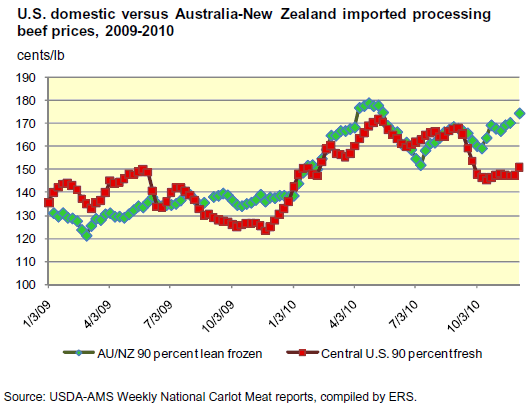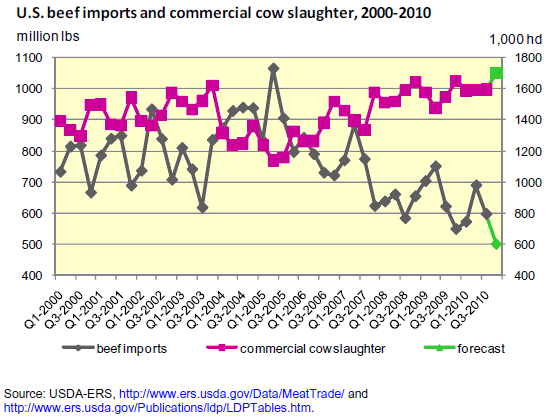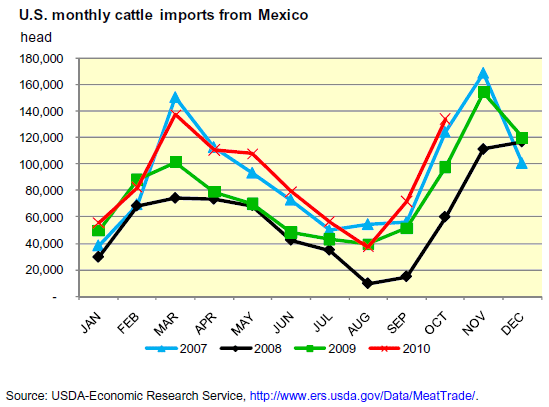



US Livestock, Dairy, and Poultry Outlook - December 2010
There are good export opportunities for both beef and dairy products in the New Year, according to the latest report from the USDA's Economic Research Service.
Beef/Cattle: Cow slaughter continues at high rates, given the cow inventory base, which along with a high ratio of heifer-to-steer slaughter implies continued liquidation. Feeder cattle continue to be placed in feedlots in year-over-year larger numbers, despite lower supplies of feeder cattle outside feedlots.
Beef/Cattle Trade: US beef exports for 2010 are forecast at 2.3 billion pounds, just under the forecast for beef imports of 2.36 billion pounds. The United States should be a net beef exporter in the fourth quarter of this year, exporting and importing 650 and 500 million pounds, respectively. Year-over-year cattle imports remain strong, 16 per cent higher than 2009, as large numbers of Mexican cattle crossed the border weekly in November and early December.
Dairy: An expected rise in domestic use, along with good export prospects and only a moderate rise in milk production, are expected to keep milk prices in 2011 very near 2010 levels. However, higher feed prices will likely squeeze producer profits in the upcoming year.
Beef/Cattle
High Fed Cattle Prices Counter High Corn Prices, Bolstering Feeder Cattle Prices
Although irrigated winter wheat pasture appears to be in relatively good shape, dryland winter wheat pasture in some areas of the Southern Plains is not developing very rapidly and likely will not provide much pasture this winter. This could result in some lightweight feeder cattle entering feedlots, despite relatively high corn prices, especially given hedging opportunities available recently. Despite the winter wheat pasture outlook, lightweight feeder cattle have sold at very respectable prices into December.
Weekly federally inspected cow slaughter continues at rates above last year's already high rates, given January 1 cow inventories. Weekly beef cow slaughter for October through November 27 has averaged about 4 per cent over the same period last year, and dairy cow slaughter has averaged over 8 per cent above a year earlier. These rates almost ensure that cow inventories on January 1, 2011 will be lower than those on January 1, 2010. Canadian cows have contributed to US slaughter numbers, but they account for only about 3 per cent of total US commercial cow slaughter.
Feeder cattle supplies outside feedlots on October 1, 2010 declined by almost 4 per cent from October 2009. This decline is consistent with the increased feedlot placements observed since August. The estimated decline in feeder cattle supplies from July 1 to October 1 was about 21.5 per cent, a decline that is large compared with other years since 2001, which typically have ranged from 19.4 to 20.6 per cent of July 1 supplies. Combined with some evidence that these cattle are entering feedlots at slightly lighter weights than for comparable periods during the last 2 years, these declines may suggest that feeder cattle are being pulled forward into feedlots. As a result, feeder cattle supplies for 2011 will likely be reduced. At the same time, if available supplies of feeder cattle are pulled forward in sufficient numbers, the potential in 2011 for beef production to exceed production for the same periods in 2010 exists, at least during the first quarter of the year. At some point in 2011, the tight supplies of feeder cattle should begin to adversely affect placements and subsequent marketings of fed steers and heifers.
Fed cattle prices have also held up nicely, likely as a result of the contribution of byproduct values to packer margins, which allows packers to bid more for cattle under some conditions. Byproduct values are at levels not observed since July of 2008, largely due to recent increased demand for hides, hearts, and some of the other edible byproducts. The strength in the wholesale sector has been possible because of strength in the retail sector, which has been supported by relatively high prices for both pork and poultry. Retail Choice beef prices for November 2010 were again counter-seasonally higher by less than 1 per cent over October 2010 and by 4 per cent over November 2009 prices.
Beef/Cattle Trade
Beef Export Levels: Boosted by More than Just Japan and South Korea
US beef exports for 2010 are forecast at 2.3 billion pounds, 19 per cent higher than 2009 levels. Exports through October were 17 per cent higher year-over-year. As in September, the United States was a net exporter of beef during the month of October. On a volume basis, US exports rarely exceeded imports prior to December 2003 and have done so only on a few occasions since then. Through October, US exports show a recovery of 91 per cent of pre-BSE levels after the posting of year-over-year growth of 25 per cent to Japan and 119 per cent to South Korea. In 2003, Japan and South Korea combined were responsible for 60 per cent of US beef exports. Through October, the share of exports for Japan and South Korea is 28 per cent, suggesting that increased exports to these countries do not fully explain the significant gain towards pre-BSE levels achieved this year.
Exports to Taiwan, Hong Kong, Egypt, and other countries, including Russia, have also helped to significantly boost 2010 total US export levels closer to the historical levels posted in 2003. Exports to Taiwan, Hong Kong, and Egypt were 46, 51, and 101 per cent higher, year-over-year, and along with sales to Vietnam and Russia, constituted 23 per cent of total US beef exports through October. Fourth-quarter exports this year are expected to show over 25-per cent growth, reaching 650 million pounds. Annual beef exports in 2011 are forecast at 2.3 billion pounds, with quarterly year-over-year growth expected to continue through the first half of the year.
The United States Is a Net Exporter of Beef in the Fourth Quarter
US beef imports for 2010 are forecast at 2.36 billion pounds, a 10-per cent yearover- year decline. Imports through October were 11 per cent lower than the comparable 2009 levels. With fourth-quarter imports forecast at 500 million pounds, the United States is expected to be a net exporter of 150 million pounds of beef in the final quarter of this year. Tighter supplies of beef available for export from Oceania explained lower import levels though much of the first half of the year. However, as more beef was shipped from Australia to all destinations in the second half of 2010, the strong Australian dollar became the predominant factor limiting US imports of beef from this historically top supplier. Beef imports from New Zealand are also 6 per cent below year-earlier levels though October, and Brazil ceased beef shipments to the United States beginning in the second half of the year.
The high Australian dollar is the predominant factor limiting imports of Australian beef, as US importers must pay relatively higher prices for the Australian product, evidenced in imported processing beef prices. In November, the Australian dollar reached highs not seen in decades against the US dollar, at $1.012 AUD/USD. According to AMS Weekly National Carlot Meat reports, the gap between US domestic and imported Australian/New Zealand processing beef at the US port of entry has widened significantly since October. Total Australian beef exports are down just over 2 per cent, but exports to the United States are down over 28 per cent, year-over-year.

Increased numbers of slaughtered cows in the United States— up over 4 per cent to date despite the already diminished US cow herd—have been able to partially offset the decrease in imports of processing beef this year. US cow slaughter and beef imports, both providing meat to the supply of processing beef, are often inversely related. US beef imports for 2011 are forecast at 2.5 billion pounds, a 4- per cent increase. Much of this growth will take place in the second half of the year, as increased shipments from Oceania are expected as the year progresses. Any strengthening of the US dollar will also help product flows to the United States.

Total Cattle Imports of 2.3 Million Head Forecast for 2010
Cattle imports for 2010 have been revised up to 2.3 million head. Cattle imports through October from Mexico and Canada, respectively, are 31 and 6 per cent above year-earlier levels. Cattle imports from Mexico have been particularly strong leading into the fall and are following the seasonal trend, in which Mexican imports typically peak in November. September and October were the strongest months for Mexican cattle imports in several years.

In addition to large numbers of slaughter steers and heifers from Canada, AMS weekly reports also show steady numbers of Canadian cull cows crossing the border, contributing to the “heavy” slaughter cattle import mix (cattle weighing more than 700 lbs.). Total cattle imports to the United States through October were over 16 per cent higher, year-over-year. The expected smaller North American cattle inventory in 2011 will likely result in decreased numbers of cattle traded; 2011 imports are forecast at 2.1 million head, a 9-per cent decline from this year.
Dairy
Firm Demand Will Likely Keep Milk Prices Near 2010 Levels; However, Higher Feed Prices Will Narrow Producer Profits
Feed prices are expected to be much higher for dairy producers next year. The USDA forecast corn price is expected to be $4.80 to $5.60 a bushel for the 2010/11 crop year. Soybean meal prices, while projected to be higher, will not rise as much as corn. They are expected to be $310 to $350 per ton in 2010/11, up from a $311 per ton average in 2009/10. The increase in feed ingredient prices will boost the benchmark 16-per cent protein mixed dairy ration price nearly 20 per cent above 2010. Higher feed costs are already pressuring producers but will not likely affect cow numbers until the second half of 2011. Cow numbers will continue to increase through the first half of 2011 and are expected to decline slightly in the second half of the year. These changes are expected to leave the herd size next year slightly above the 9,110 thousand head in 2010 at a projected 9,125 thousand head. Milk per cow is forecast to continue to rise next year, but at less than half the pace forecast for 2010. The current year’s increase in milk per cow was aided by good weather in addition to moderate feed prices. Overall, milk production will be slightly higher next year at 195.5 billion pounds, up 1.4 per cent from the 2010 estimated total of 192.8 billion pounds.
Milk equivalent imports on both a fats and skim-solids basis are forecast to be lower in 2010. The fact that international prices are still above US domestic prices for the major dairy products, and that the domestic economic recovery is gradual will limit import totals to 4.1 billion pounds next year, down from 4.3 billion this year on a fats basis and down to 4.9 billion pounds from 5.1 billion this year on a skimsolids basis. Milk equivalent exports rebounded sharply this year from 2009. However, next year exports on a fats basis are expected to weaken to 6.3 billion pounds from the 8.3 billion pound total expected this year. Uncertainty over the Mexican tariff on US cheese exports is contributing to the decline. On a skimsolids basis, exports are forecast to decline slightly to 30 billion pounds from a projected 31.3 billion pound total expected this year. Oceania milk production is forecast to increase in 2011, raising competition in export markets.
Domestic commercial use on a fats basis is expected to rise by nearly 2 per cent in 2011; this would be the sharpest year-over-year rise in at least 4 years. Domestic commercial use on a skim-solids basis is forecast to climb by nearly 3 per cent in 2011. The rise would follow a better than 2-per cent year-over-year decline expected in 2010.
Strong domestic use, a good export outlook, and only a moderate increase in milk production provide the basis for continued strong price performance estimates for dairy products into 2011. While butter prices have retreated from earlier peaks, the 2010 average price is expected to be $1.685 to $1.715 per pound this year. Prices in 2011, while not as high as this year’s, will still be above those of recent years averaging $1.485 to $1.595 per pound. Despite uncertainty in the cheese export market, domestic demand should be sufficient to boost cheese prices next year.
Cheese prices in 2010 are expected to average $1.515 to $1.525 per pound, rising to $1.535 to $1.615 per pound in 2011. Nonfat dry milk (NDM) prices are also projected higher next year. NDM prices are expected to average $1.160 to $1.180 per pound this year and climb to $1.200 to $1.260 per pound in 2011. Whey prices are likely to average 36.5 to 37.5 cents per pound in 2010 and 36.5 to 39.5 cents per pound next year.
Export prospects for NDM should help keep Class IV milk prices firm into 2011, but not quite as high as this year’s $15.00 to $15.20 per cwt expected average. In 2011, Class IV milk is forecast to average $14.50 to 15.40 per cwt. Class III milk prices should be higher next year. For 2010, the Class III price is expected to average $14.35 to $14.45 per cwt and to climb to $14.45 to $15.25 next year. On balance, this leaves the all milk price next year at $15.90 to $16.70 per cwt, virtually unchanged from the 2010 projected average of $16.25 to $16.35 per cwt.
December 2010


